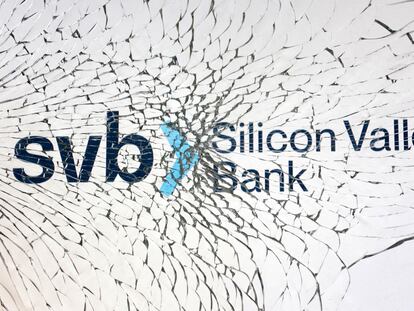The Silicon Valley Bank collapse exposes weaknesses in US banking system
The California bank is now looking for a buyer after its debacle this week

Silicon Valley Bank (SVB) is not Lehman Brothers. Friday’s collapse of the Californian bank is not going to unleash a debacle like the crisis that financial institution precipitated in 2008. But its case, which triggered the largest single-day deposit withdrawal in recent US history, has highlighted a number of vulnerabilities in the system, which have their origins in the pandemic and to which smaller institutions are more exposed.
Like many other banks in the United States, SVB saw its cash deposits skyrocket in the wake of the covid pandemic and the confinements that followed. Since April 2020 and for almost three years, nearly $4.2 trillion (3.95 trillion euros) was deposited in the banks. Many financial institutions chose to invest a good proportion of this money - in total, some two trillion dollars - in fixed-income bonds. Specifically in government bonds, which are considered very low risk compared to new lending.
For a couple of years, the idea worked. But then came the era of inflation: a price hike of a size - it reached 9.06% in June last year - and a duration not seen since the 1970s. This escalation and the rise in interest rates led to a drastic fall in the price of these bonds, and a $600 billion hole on paper for the banks. This is a manageable amount for the industry as a whole, and especially for the larger banks and those that did not invest heavily in these securities. But it created risks for small and regional banks that had bet too much on this strategy. Entities such as Pac West, another Californian bank, accumulated a billion dollars in losses, a quarter of its capital. This bank has seen the value of its shares fall by 50% this week.
SVB is an extreme case of this dynamic. This entity had specialized in financing in the technology sector, especially startups for which access to capital is more difficult in their early stages. Its portfolio includes companies such as Beyond Meat, which specializes in vegetarian products, and the communications giant Discovery. Most of his deposits, in fact, do not correspond to individuals, but to companies in the sector. And around 50% of these deposits were invested in bonds.
When these securities began to lose value in the face of rising rates, the bank accumulated losses of $15 billion on paper, slightly less than the value of the entire institution. Customers began to withdraw their deposits and take them to other institutions. SVB began to look for measures to try to alleviate this weakness. Among other things, it sold some of the bonds it had bought at a loss of $1.8 billion.
Warnings on Thursday
Some venture capitalists began advising startups on Thursday to withdraw their funds. Panic broke out among the bank’s clients. That day a race began to withdraw the funds deposited with the bank. 42 billion dollars vanished from SVB’s books, more than one million dollars per second over the ten working hours of the day. The largest outflow of funds from a bank in modern times in the US: until then, the record was held by Washington Mutual in 2008, when $16.7 billion was withdrawn in ten days.
The drain at SVB was an unbearable amount for any institution, let alone a relatively small bank. That loss on paper became real. According to the California Department of Financial Protection and Innovation, Silicon Valley Bank had an overdraft of $958 million on Friday.
That day, regulators took control of the bank. Trading in its shares was suspended, pending further information on the Californian entity’s situation. As of December 31, 2022, the bank had some $209 billion in assets (€196 billion) and $175.4 billion in deposits. SVB is now looking for a buyer, which would allow it to calm investors and reopen customer accounts.
The technology sector, under pressure
Among the questions left by the failure is to what extent it will affect the technology sector, and what will happen to deposits beyond the $250,000 guaranteed by US regulators. That amount is sufficient in the vast majority of cases for an ordinary citizen, but not for a company that uses its funds in the bank to cover its payroll.
The next few days will be key in determining to what extent the bank’s failure becomes a problem for its customers (and their employees), how much money they can withdraw, and when. It’s a fundamental question for many of them: given that at many US companies payrolls are biweekly, the next payday arrives on Wednesday, the 15th. Among those affected is cryptocurrency firm Circle, which has revealed that it held 3.3 billion of its 40 billion reserves in SVB, leading to repercussions in the cryptocurrency market as well. Regulators have only advanced that depositors who counted more than $250,000 in the bank “will receive an advance dividend over the next week”.
For the time being, the US financial authorities have appealed for calm. Treasury Secretary Janet Yellen has stressed that the banking system “remains resilient” and that regulators “have effective tools to respond to this type of situation,” her department said in a statement. Yellen met Friday with representatives from the Federal Reserve, the Federal Deposit Insurance Corporation and others to address the SVB case.
Democratic lawmaker Eric Swalwell of California has stressed the need to protect deposits above $250,000 at the bank. “The key to banking is trust,” he has said. “If depositors lose confidence in the safety of their funds above $250,000, then we will have a problem.”
Sign up for our weekly newsletter to get more English-language news coverage from EL PAÍS USA Edition
Tu suscripción se está usando en otro dispositivo
¿Quieres añadir otro usuario a tu suscripción?
Si continúas leyendo en este dispositivo, no se podrá leer en el otro.
FlechaTu suscripción se está usando en otro dispositivo y solo puedes acceder a EL PAÍS desde un dispositivo a la vez.
Si quieres compartir tu cuenta, cambia tu suscripción a la modalidad Premium, así podrás añadir otro usuario. Cada uno accederá con su propia cuenta de email, lo que os permitirá personalizar vuestra experiencia en EL PAÍS.
¿Tienes una suscripción de empresa? Accede aquí para contratar más cuentas.
En el caso de no saber quién está usando tu cuenta, te recomendamos cambiar tu contraseña aquí.
Si decides continuar compartiendo tu cuenta, este mensaje se mostrará en tu dispositivo y en el de la otra persona que está usando tu cuenta de forma indefinida, afectando a tu experiencia de lectura. Puedes consultar aquí los términos y condiciones de la suscripción digital.
More information
Archived In
Últimas noticias
The life of a delivery driver in China: ‘Many people don’t know how an order can arrive at their home in just one day’
Maude Apatow, from acting in ‘Euphoria’ to directing: ‘There are many films that you can tell weren’t written by someone young’
The guardians of the meteorites of the Argentine Chaco
Helen Levitt, the photographer who captured the theater of the everyday
Most viewed
- Christian Louboutin: ‘Young people don’t want to be like their parents. And if their parents wear sneakers, they’re going to look for something else’
- US sanctions against jailed cartel leader ‘El Marro’ highlight Mexico’s lack of control over its prisons
- Cartels in Mexico take a leap forward with narco-drones: ‘It is criminal groups that are leading the innovation race’
- Liset Menéndez de la Prida, neuroscientist: ‘It’s not normal to constantly seek pleasure; it’s important to be bored, to be calm’
- ‘El Limones’ and the growing union disguise of Mexican organized crime











































